Auburn University announced Tuesday that research done by the Auburn College of Veterinary Medicine has contributed to a gene therapy treatment that was administered to its first human patient this summer.
The gene therapy is designed to fight the deadly disease GM1 gangliosidosis. Auburn graduates Sara and Michael Heatherly of Opelika had their son, Porter, taken from them by GM1 in 2016. Porter was the first confirmed case of GM1 in Alabama.
According to the National Institutes of Health (NIH) website, “GM1 gangliosidosis is an inherited disorder that progressively destroys nerve cells (neurons) in the brain and spinal cord.”
GM1 gangliosidosis is estimated to occur in one in 100,000 to 200,000 newborns.
The NIH says, “The signs and symptoms of the most severe form of GM1 gangliosidosis, called type I or the infantile form, usually become apparent by the age of 6 months. Infants with this form of the disorder typically appear normal until their development slows and muscles used for movement weaken.”
A 10-year-old girl named Jojo became the first patient to receive the Auburn-linked gene therapy treatment during a human clinical trial this summer at the National Institutes of Health in Maryland.
“Jojo is doing well and has experienced no major complications,” said Dr. Doug Martin, a professor in the Department of Anatomy, Physiology and Pharmacology in Auburn’s veterinary college and the Scott-Ritchey Research Center.
Auburn’s College of Veterinary Medicine and the University of Massachusetts Medical School developed the treatment that has moved from helping cats with GM1 with the hope of helping children.
Auburn scientists for several decades have researched treatments to improve and extend the lives of cats affected by GM1. Martin is leading Auburn’s effort, which was started by his mentor, Professor Emeritus Henry Baker.
According to the Universities Federation for Animal Welfare (UFAW), the prevalence of GM1 among cats is not known, but the effects on victims of the disease are similar across species.
According to the UFAW website, “Affected cats exhibit no signs of the disease at birth, clinical signs start to occur from 2-3 months of age and steadily progress to severe until one year of age when cats are euthanized.”
To move the treatment toward human medicine, Martin developed a partnership with UMass Medical School researchers Drs. Miguel Sena-Esteves and Heather Gray-Edwards, an Auburn alumna — and they have worked collaboratively for 15 years, combining animal and human medicine studies to cure rare diseases that affect both animals and humans.
In December 2018, the gene therapy was licensed to Axovant Gene Therapies Ltd., a clinical-stage company developing innovative gene therapies.
“This treatment is extremely promising because it has worked well in GM1 mice and cats, and it is delivered by a single IV injection that takes less than an hour, we’re hopeful that the treatment makes a real difference for patients and their families,” said Martin.
“The NIH is hoping to begin treating three or four more children in the next few months. As the trial progresses and more patients are treated, we’ll have a good idea of whether the gene therapy helps children as much as it has helped the animals,” Martin continued.
The NIH clinical trial is led by Dr. Cynthia Tifft, deputy clinical director at the National Human Genome Research Institute.
“GM1 gangliosidosis is a devastating disease in young children, for which there are no currently approved treatment options. The development of a safe and effective gene therapy for these patients would be a welcome advancement in the field of pediatric lysosomal storage disorders affecting the brain,” Tifft said.
“Seeing all of the effort come together to help patients who have no treatment options today gives us great hope,” said Martin.
For Sara and Michael Heatherly of Opelika, who have held fundraisers for several years to support the research, the knowledge of a treatment is one of mixed emotions.
“We are excited to know there is hope for the future of children diagnosed with GM1,” Michael Heatherly said. “We are thankful for everyone who has dedicated their time, resources and careers to move this treatment forward and to Axovant for bringing all of their work to life and making it a reality for GM1 patients.
“We understood early on the research would not help Porter, but we wanted to help spread the word of the research and the progress that was being made.”
Henry Thornton is a staff writer for Yellowhammer News. You can contact him by email: [email protected] or on Twitter @HenryThornton95.













